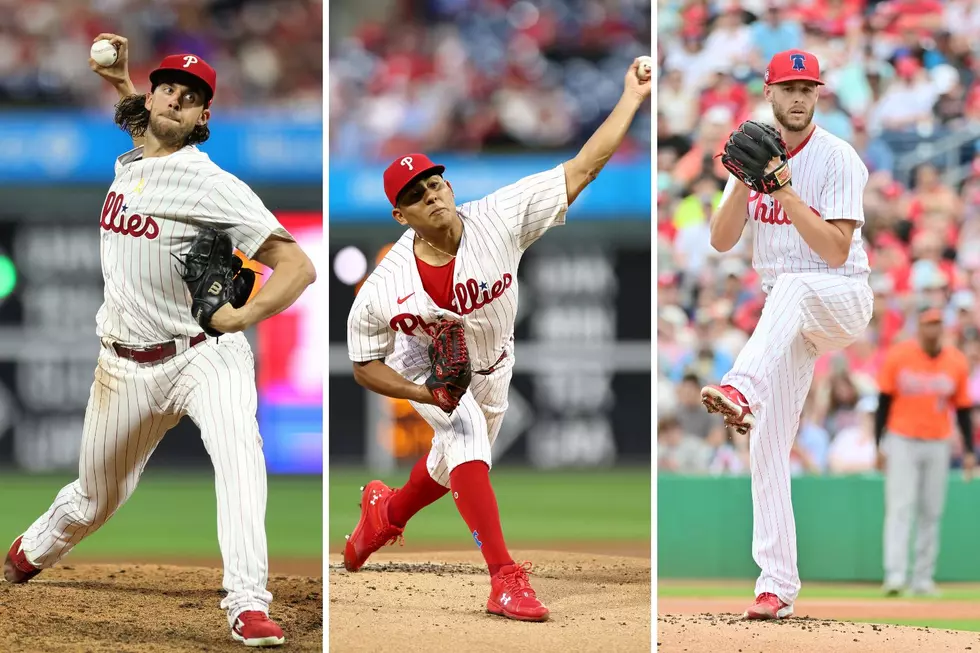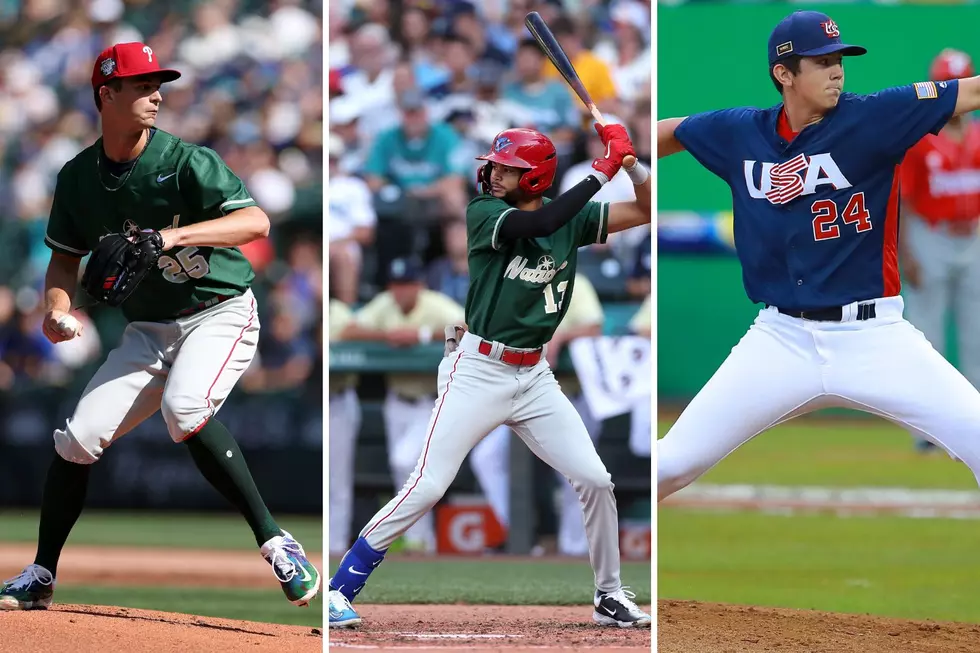
“V” For Halladay’s Velocity
Everybody gets shelled. It’s sorta kinda an occupational hazard of pitching professionally.
Now, this might be the opportune moment to roll in some cutesy segue about how the Braves crushed Roy Halladay in the Phils 15-13 extra-inning loss last night. (Wait for it… “But Roy Halladay doesn’t!” … Long, rhetorical pause. To let the joke marinade. Check in on the laughter. Yeah, no. Stupid.) But I’m not going there. One, because even Wisconsin doesn’t have enough cheese to accommodate. And two, because it’s actually something of a serious, not-so-silly problem.
Some due dilligence:
– Halladay’s line — 5.1 IP, 12 H, 8 ER, 2.25 WHIP, 13.50 ERA — matched the fourth-worst shellacking of his career. The other game was dated September of 2000.
– His earned run total was his second-highest ever. The first? From his second season in the bigs. In 1999. (Though, it should be noted, in that game, he forked up 11 runs in 2.1 innings. For a 42.43 ERA. But still.)
– Entering the fourth inning, Halladay’d been graced with a four-run lead 118 times in his career. His team only lost eight of those games. Halladay? Not a one.
– !!!ADVANCED STATS WARNING!!! Halladay’s win probability added yesterday (-0.587, which, basically, means that, with the way the guy was tossing softballs yesterday — intentional pun we’re getting to momentarily — his team stood a 58.7 greater chance of losing … how often didjya ever think you’d say that about the Good Ol’ Doc?) was the worst of his career.
Granted, that, itself, doesn’t really tell you the whole picture.
Though it does do a vast majority of the stroking (…), considering the Braves were the first legitimately potent lineup he’d faced all year. Basically, Atlanta (3rd in baseball in runs, 5th in batting average, 10th in OBP, 10th in slugging) is USP Labs’ Jack3d, to the rest of the coconut water — the Cubs (25th, 21st, 26th, 26th), Padres (26th, 29th, 21st, 30th), Giants (19th, 11th, 17th, 12th), Marlins (29th, 28th, 27th, 24th) and Pirates (30th, 25th, 29th, 27th) — that round out Halladay’s 2012 gamut.
Still, we’ll note that, given Halladay’s line against them — 37 IP, 8 ER, 2.4 K/BB ratio, 1.95 ERA — and our deference to that age-old sports cliche that “you can only play the teams on your schedule” it’s worth noting that, indeed, the guy’s done markedly well against just about everybody he’s faced.
Until last night.
Which, so far as we’re concerned, ought to be the proper chronology of diving into this whole “V For Roy Halladay’s Waning Velocity” thing that Ken Rosenthal, Matt Gelb (Philly.com), David Hale (Wilmington News-Journal) and just about everybody else with a vested interest in the guy’s gas dove face-first into.
Which is to say that, it shouldn’t be a problem until it’s a problem.
And no, last night isn’t quite a pointed, “Break The Glass” moment. But, yeah, your hand has to be hovering uncomfortably close, twitching pretty anxiously and, maybe, spitting out some beads of liquid worry from its palms. Which, admittedly, dry up pretty quickly when you peep the schedule and note that due up next for the Doc is Jon Niese (2-1, 4.08 ERA) and the Mets (against who, over the last 10 years, he’s gone 9-2 with a 2.88 ERA and 61 strikeouts).
Why? Because we know how this is going to play out. (For now.) Halladay’s going to power-walk out to the mound, with careful, calculated intent on eating the skin off of the face of every opposing batter he sees, dialed into bucking the swirling B.S. about his arm strength and execution and prevailing strategy behind it all, and pull it off. Not so much because he’s a gamer like that. (Though he totally is. So much so that It’s been said – in jest, by people like me, who are kidding, and make parenthetical parsings in their jokes for fear that people might think they’re serious, when, again, they’re not — that he ghost-operates Curt Schilling’s gaming company.) But because of the next softie the MLB scheduling committee swirled in their early, regular season waffle cones, the Mets, his competition.
And that’s unfortunate. Because, until he gets whomped in some relative proximity from one start to the next, by teams that matter in games that matter, people are going to assume that the problem has just mystically dissipated into the history of the game like Jamie Moyer won’t.
It won’t have. It’ll still totally be there. And does present potentially – potentially – lingering, long-term implications, the obvious ones you can drum up on-command.
Basically, the issue is two-fold. For one — and this might be the simplest spelling out of a situation we’ll ever do here, despite the endless efforts of just about everybody with a platform to imply the opposite — the guy’s velocity is down. Down, down, down. Not staying level. Not dipping, but ever so slightly and hardly noticeably. Down. Down, down, down. OK? Are we clear?
No?
Well…
First comes this, a comp (compliments of MLB PitchFX numbers dug up by Texas Leaguers, via Hale) of the guy’s velocity and pitch selection for his first four starts in this and last season:
| Pitch | 2011% (velo) | 2012% (velo) |
| 2-seam | 23.6% (91.4) | 10.5% (90.1) |
| Cutter | 20.9% (90.7) | 50.6% (88.7) |
| Curve | 12.7% (77.1) | 22.8% (76.4) |
Which, basically, supports what, basically, everybody’s said: Yeah, the guy has lost about a mile an hour on his stuff across the board over the turn of a calendar year. Why does it matter where he’s lost what? Because some baseball scribes (particularly the ones in Philly, who, no, aren’t playing homer — at least we don’t think they are — but, more likely, are trying to flip that the Philadelphia fan base, with more Homers than a Simpsons beer league home run derby (which, yeah, I guess wouldn’t be that many, but still…), can cling to) are trying to write it off as adjustments the guy is making to not only his repertoire and his selection, but, top-to-bottom, his entire approach to getting guys out. (Though, it should be noted, Hale notes that he’s “not sure Rosenthal is completely wrong to offer some concern though. After all, the velocity numbers are definitely down.”) That makes for presumed issue No. 2, that the guy needs some time to figure out his stuff. Which, it seems, he does.
Except for, it kinda sort of clashes with the takeaway of an ongoing, three-year trend.
Wrote Todd Zolecki of MLB.com, (coincidentally, in an article that dutifully argued the point that Halladay’s velocity hasn’t bottomed out relative to 2011, yet, all at once, concedes the point that it has, pretty clearly, begun an annual step-wise descent) back in April:
“Halladay’s two-seam fastball has averaged 90.71 mph this season, compared to 92.71 mph in 2011, 93.29 mph in 2010 and 93.74 mph in 2009. His cutter has averaged 89.16 mph this season, compared to 91.46 mph in 2011, 92.01 mph in 2010 and 92.00 mph in 2009.”
Don’t know about you, but three, solid, ever-manipulative miles per hour in as many years makes for a totally different dude, if you ask me. (Before you get going, no, we don’t think that a perfectly linear trend that’s going to carry on into perpetuity. Though it could.) And absolutely matters, for the team still slated to shell out three years and $60 million to a guy who’s got 35 years and over 2,500 innings on the odometer. And rotator cuff. And UCL. And other super important stuff.
Ultimately, chicken and egg isn’t really the issue here. (That is, whether Hallday’s velocity is tapering off while he’s trying to figure some new tricks out, or, that Halladay trying to figure new tricks out because his velocity is tapering off.) Never was. The issue was whether it was going to be an issue.
Last night, dude had issues.
Hence, the problem.
(Insert ceremonious part about Cliff Lee being shelved and the Phillie offense being a mortal sin to the offensive history of the sport, and Cole Hamels track record of thriving much more in an ancillary role, when he’s not leaned on like a light post outside a bar, and, worse, his similar documented history of buckling the one-and-only time he had to be “the guy,” and whatever implications Doc’s future might have on Cole’s impending free agency, and how super-duper important it is that, for a zillion reasons, Halladay hangs on for the foreseeable future.)
Now, we do have faith in the Doc because, simply, he is, bar-none, one of the game’s elite students — maybe most of all of himself.
Here’s how I think about it: Remember how in grade school, you learned that, if you’re super-duper far away from something (say, Planet Earth) and are somehow able to see said something that’s X number of light years away, what you’re seeing comes to you on delay of that same X number of years, given that it takes that same, X number of years for light (the stuff you see) to travel at, you guessed it, the speed of light?
Well, basically, we’re light years removed from Halladay’s intimacy to his own situation. So whatever we’re getting now, Halladay has probably seen coming, and been making the appropriate accommodations, for a really long time. Not the least of which was the blaringly obvious reality that’s probably been cooking since the guy first picked up a baseball, that pitcher’s don’t last forever.
Still, we’re going to remember this come his next big match-up, completely dismissive and clear-minded of any and everything that happens in between, against teams that, very much like the Cubs and Padres and Giants and Marlins and Pirates, are Fluffer Nutters, relative to the Sammiches of Steel that round out the top shelf (a list of teams you wouldn’t believe unless I showed you) of the NL’s elite scorers. As should you.
Because until Halladay proves, against teams like those, that this isn’t a problem, it is, and will always be, a problem.
(This article was written by Matt Hammond, he can be reached at matthammond89@gmail.com)
More From 97.3 ESPN









